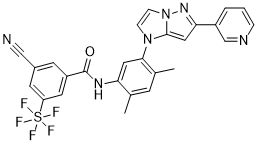BAY-826
This product is for research use only, not for human use. We do not sell to patients.

For small sizes, please check our retail website as below: www.invivochem.com
| Size | Price | Stock |
|---|---|---|
| 100mg | $1650 | To Be Confirmed |
| 250mg | $2650 | To Be Confirmed |
| 500mg | $3975 | To Be Confirmed |
Cat #: V4169 CAS #: 1448316-08-2 Purity ≥ 98%
Description: BAY-826 is a novel, highly potent, selective and orally available small molecule TIE-2 inhibitor with Kd of 1.6 nM, respectively.
Top Publications Citing Invivochem Products
Publications Citing InvivoChem Products
Product Promise

- Physicochemical and Storage Information
- Protocol
- Related Biological Data
- Stock Solution Preparation
- Quality Control Documentation
| Molecular Weight (MW) | 558.53 |
|---|---|
| Molecular Formula | C26H19F5N6OS |
| CAS No. | 1448316-08-2 |
| Storage | -20℃ for 3 years in powder formr |
| -80℃ for 2 years in solvent | |
| SMILES Code | O=C(NC1=CC(N2C=CN3N=C(C4=CC=CN=C4)C=C32)=C(C)C=C1C)C5=CC(S(F)(F)(F)(F)F)=CC(C#N)=C5 |
| Synonyms | BAY826; BAY 826; BAY-826 |
| Protocol | In Vitro | BAY-826 is a selective and potent inhibitor of TIE-2 (dissociation constant = 1.6 nM) and binds with similar high affinity to only 4 of 456 tested kinases, namely, TIE-1, DDR1, DDR2, and Serine/threonine-protein kinase 10 (LOK) (dissociation constant = 0.9, 0.4,1.3, and 5.9 nM).The high biochemical affinity for TIE-2 translates into very potent cellular mechanistic activity with an EC50 of about 1.3 nM for inhibition of TIE-2 autophosphorylation in human umbilical vein endothelial cells. The TIE-2 inhibitor BAY-826 is tested for its acute growth inhibitory as well as anti-clonogenic properties in all four mouse glioma cell lines. BAY-826 is highly selective against other angiogenic kinases, such as VEGFR, fibroblast growth factorreceptor (FGFR), or Platelet-derived growth factor receptor (PDGFR), and affects VEGF-stimulated proliferation of HUVEC only atμM concentrations, respectively. |
|---|---|---|
| In Vivo | BAY-826 improves tumor control in syngeneic mouse glioma models. Co-treatment with BAY-826 and irradiation is ineffective in one model (SMA-497), but provided synergistic prolongation of survival in another (SMA-560) cell. TIE- 2 inhibition may improve tumor response to treatment in highly vascularized tumors such as glioblastoma. BAY-826 (oral gavage; 25 mg/kg,50 mg/kg,100 mg/k) potently inhibits ANG-1-stimulated TIE-2 autophosphorylation in murine lungs in female CB17/scid mice. |
These protocols are for reference only. InvivoChem does not
independently validate these methods.
| Solvent volume to be added | Mass (the weight of a compound) | |||
|---|---|---|---|---|
| Mother liquor concentration | 1mg | 5mg | 10mg | 20mg |
| 1mM | 1.7904 mL | 8.9521 mL | 17.9041 mL | 35.8083 mL |
| 5mM | 0.3581 mL | 1.7904 mL | 3.5808 mL | 7.1617 mL |
| 10mM | 0.1790 mL | 0.8952 mL | 1.7904 mL | 3.5808 mL |
| 20mM | 0.0895 mL | 0.4476 mL | 0.8952 mL | 1.7904 mL |
The molarity calculator equation
Mass(g) = Concentration(mol/L) × Volume(L) × Molecular Weight(g/mol)
Mass
=
Concentration
×
Volume
×
Molecular Weight*
The dilution calculator equation
Concentration(start)
×
Volume(start)
=
Concentration(final)
×
Volume(final)
This equation is commonly abbreviated as: C1 V1 = C2 V2
Concentration(start)
C1
×
Volume(start)
V1
=
Concentration(final)
C2
×
Volume(final)
V2
Step One: Enter information below
Dosage mg/kg
Average weight of animals g
Dosing volume per animal µL
Number of animals
Step Two: Enter the in vivo formulation
%DMSO
+
%
+
%Tween 80
+
%ddH2O
Calculation Results:
Working concentration:
mg/ml;
Method for preparing DMSO master liquid:
mg
drug pre-dissolved in
µL
DMSO(Master liquid concentration
mg/mL)
,Please contact us first if the concentration exceeds the DMSO solubility of the batch of drug.
Method for preparing in vivo formulation:
Take
µL
DMSO master liquid, next add
µL
PEG300, mix and clarify, next add
µL
Tween 80,mix and clarify, next add
µL
ddH2O,mix and clarify.
Note:
- (1) Please be sure that the solution is clear before the addition of next solvent. Dissolution methods like vortex, ultrasound or warming and heat may be used to aid dissolving.
- (2) Be sure to add the solvent(s) in order.




































